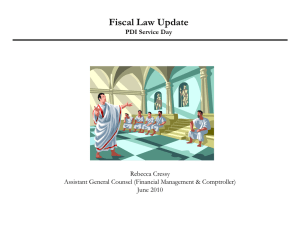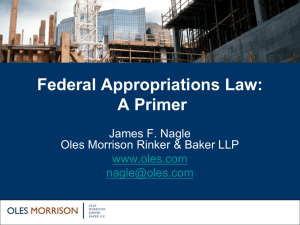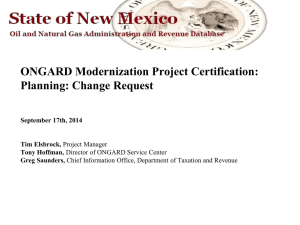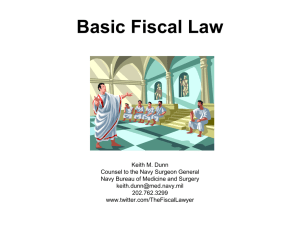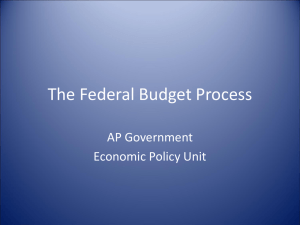Session 1 - Course 01 - Fiscal Law
advertisement
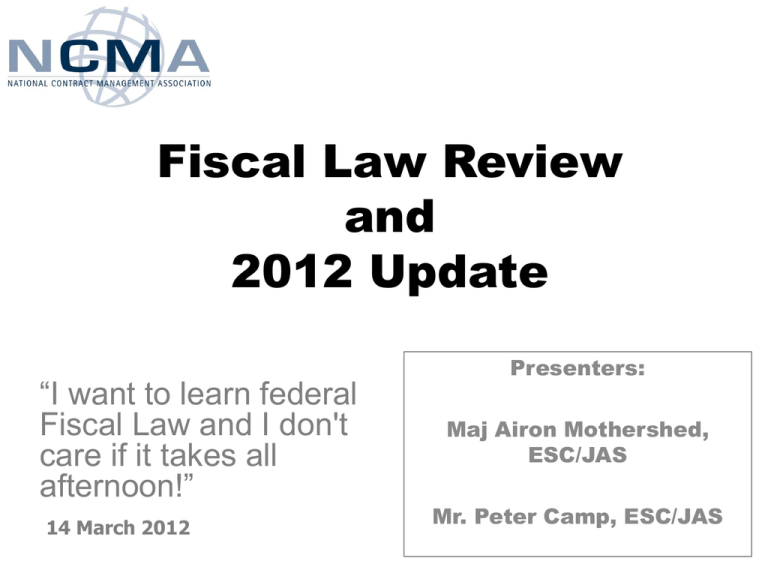
Fiscal Law Review and 2012 Update “I want to learn federal Fiscal Law and I don't care if it takes all afternoon!” 14 March 2012 Presenters: Maj Airon Mothershed, ESC/JAS Mr. Peter Camp, ESC/JAS DISCLAIMER THE VIEWS EXPRESSED IN THIS PRESENTATION ARE THOSE OF THE PRESENTERS AND MAY NOT REFLECT THE OFFICIAL POLICY OR POSITION OF THE DEPARTMENT OF DEFENSE OR THE UNITED STATES AIR FORCE 2 Overview • Fiscal Law’s Three Pillars – Purpose – Time – Amount • Exceptions • Sanctions & the Antideficiency Act (ADA) 3 Purpose 4 Purpose: Sources of Law • United States Constitution • United States Code • Authorization Acts – Authorize Projects – Authorize Appropriations – Enact Permanent Legislation • Appropriations Acts 5 Purpose: Where It All Begins “No money shall be drawn from the Treasury, but in consequence of appropriations made by law…” U.S. Const., Art I, Sec. 9, Cl. 7 Meaning: Only Congress can determine the purposes for which public funds may be disbursed 6 The Purpose Statute 31 U.S.C. § 1301(a) The Act of March 3, 1809, addressing perceived abuses by the military departments Little Turtle Maj Gen Arthur St. Clair St. Clair’s Defeat, Northwest Indian War Samuel Hodgdon 7 The Purpose Statute 31 U.S.C. § 1301(a) “Appropriations shall be applied only to the objects for which the appropriations were made except as otherwise provided by law.” 31 U.S.C. § 1301(a) 8 Purpose: “The Half Empty Glass” Rule “The established rule is that the expenditure of public funds is proper only when established by Congress, not that public funds may be expended unless prohibited by Congress.” U.S. v. MacCollom, 426 U.S. 317 (1976) 9 Purpose: “The Half Empty Glass” Rule “It is difficult to see how a legislative prohibition could be expressed in stronger terms. The law is plain and any disbursing officer disregards it at his peril.” You don’t need to be a pessimist to understand fiscal law, but it helps. 4 Comp. Dec. 569, 570 (1898) 10 Purpose: Sources of Law • United States Constitution • United States Code • Authorization Acts – Authorize Projects – Authorize Appropriations – Enact Permanent Legislation • Appropriations Acts 11 THE PROCESS OF ENACTMENT FEB CBO Report Congress MAR APR MAY JUN Concurrent Budget Resolution authorizations process Department Of Defense National Budget DoD Budget AUG SEPT OCT National Defense Authorization Act joint conference appropriations process President (OMB) JUL joint conference DoD Appropriations Act Apportionment Testimony & Appeals Allocation Military Departments Service Budgets Budget Execution Suballocation Program Managers/Units See DOD 7000.14-R (FMR), Vol .14 PEO/MAJCOM (AFMC) 12 Purpose: Sources of Law Appropriations Act – Appropriations Acts – 31 U.S.C. § 1301 (d) – Don’t Exceed Appropriations Without Congress’ Express Authority – Other Public Laws – Opinions Appropriations for DoD are differentiated by Service (Air Force, Army, etc.) and Component (Active, Reserve, etc.) and Purpose (O&M, Personnel, etc.) – Nearly 100 separate appropriations in all! 13 Purpose • Major Appropriations – Personnel – pay and allowances, PCS, etc. – O&M – operations and maintenance of installations, day-to-day expenses of training exercises, deployments, etc. – Procurement – production and modification of missiles, aircraft, etc. – RDT&E – basic and applied scientific research, etc. – MILCON – military construction 14 Purpose: 31 U.S.C. § 1301(a) • Three-part test – Particular statutory purpose or “Necessary Expense” • Congress does not specify every item of expenditure in an Appropriations Act. • Agencies have “reasonable discretion” • Expenditures must be “reasonably necessary” or “contribute materially” – Not prohibited by law – Not otherwise provided for 15 Purpose • Operation and Maintenance, Air Force [3400] “For expenses, not otherwise provided for, necessary for the operation and maintenance of the Air Force, as authorized by law; and not to exceed $7,699,000 can be used for emergencies and extraordinary expenses, to be expended on the approval or authority of the Secretary of the Air Force, and payments may be made on his certificate of necessity for confidential military purposes, $34,985,486,000.” – Pub. L. No. 112-74, Title II 16 Purpose • General Provisions (Title VIII) • Using funds made available by this Act or any other Act, the Secretary of the Air Force, pursuant to a determination under section 2690 of title 10, United States code, may implement cost-effective agreements for required heating facility modernization in the Kaiserslautern Military Community in the [FRG]: Provided, That in the City of Kaiserslautern and at the Rhine Ordnance Barracks area, such agreements will include the use of United States anthracite as the base load energy for municipal district heat to the United States Defense installations…. – Pub. L. No. 112-74 § 8054 17 Purpose: Continuing Resolutions • Legislation that permits continuing operations in absence of an Appropriation Act • Generally at current or lower rate • General provisions of prior year apply • No new programs may start 18 Purpose: Augmentation • Generally, it is impermissible to augment an appropriation – By paying out of the wrong appropriation – Miscellaneous Receipts violation • “Except as provided in section 3718(b) [ ] of this title, an official or agent of the Government receiving money for the Government from any source shall deposit the money in the Treasury as soon as practicable without deduction for any charge or claim.” 31 U.S.C. § 3302(b) – Accepting voluntary services without statutory authority • Obtain agreement (no cost) in writing – in advance! 19 Purpose: Investment/Expense Threshold • Expenses are costs of resources consumed in operating and maintaining DoD – Normally financed with O&M funds • Investments are acquisitions of DoD capital assets – Normally financed with Procurement funds • System cost >= $250,000 (Current threshold) • Computer buys need careful scrutiny 20 Purpose & Construction • Construction vs. Repair – Repair = O&M funds – Minor Construction • <= $750,000 O&M (or <= $1.5M if to correct a deficiency that threatens life, health or safety) per 10 U.S.C. 2805(c). – Unspecified Minor Military Construction • <= $2.0M (or <= $3M if to correct a deficiency which threatens life, health or safety) per 10 U.S.C. 2805(a) • Secretarial approval • Congressional notification (wait 21 days (14 days if the notice is submitted electronically)) – Specified Military Construction – No Project Splitting! 21 Purpose: Recent Cases • Election Assistance Commission (EAC) – Obligation of Fiscal Year 2004 Req’ts Payments Appropriations, B-318831, Apr. 28, 2010 – EAC violated the purpose statute when it obligated funds for certain grant expenditures to an appropriation that was available only for requirements payments to states – Plain language of the statute was clear – GAO held that agencies must comply with the plain meaning in their appropriations • Architect of the Capitol (AOC) – Availability of Funds for Battery Recharging Stations for POVs, B-320116, Sept. 15, 2010 – AOC asked GAO to make a decision as to whether appropriated funds could be used to purchase recharging stations for privately owned hybrid or electric vehicles – GAO: employees’ commuting expenses are “personal expenses.” The recharging stations are commuting expenses. Absent special statutory authority, may not be purchased with appropriated funds. 22 Purpose: Recent Cases • U.S. Dept. of the Navy v. Federal Labor Relations Authority, DC Circuit No. 10-1304, January 13, 2012 – For years, Naval Station Newport, RI, purchased bottled water for its federal employees with appropriated funds because of lead piping in some water fountains – By 2005, the Navy replaced all of the water fountains, bottled water was no longer necessary. Navy stopped providing it – The Labor Union argues free water bottles = employee benefit arising from custom or practice of that workplace – Arbitration: Arbitrator & FLRA agree with Union, Navy appeals The Navy appealed to the U.S. Court of Appeals – Court of Appeals:: appropriated funds may be used only for “necessary” expenses and bottled water was not a necessary expense. 23 Time 24 Time • Most appropriations have a period of availability – Specified time available for obligation • May not obligate before appropriation and receipt • Must be obligated before they expire • Exceptions are rare (statutory) – Once obligated, disbursement may be made before or after expired, but before closed – Appropriations close five years after they expire • There is no longer an M account 25 Time & Availability • Congress determines the period of availability for each appropriation • Generally – O&M – 1 year – Personnel – 1 year – RDT&E – 2 years – Procurement – 3 years – MILCON – 5 years 26 Time & Obligation • “Obligation means a legally binding agreement that will result in outlays, immediately or in the future. When you place an order, sign a contract, award a grant, purchase a service, or take other actions that require the Government to make payments to the public or from one Government account to another, you incur an obligation.” – OMB Circular A-11 (2010), at ¶ 20.5(a) 27 Time and the Bona Fide Need • The balance of an appropriation limited for obligation to a definite period of time is available only for: – payment of expenses properly incurred – during the period of availability or – to complete contracts properly made within that period of availability 28 Time and the Bona Fide Need • May expend fiscal year funds only for the bona fide needs of that same fiscal year. – 31 U.S.C. § 1502(a) • So, just what constitutes a bona fide need on 30 September? 29 Time and the Bona Fide Need: Recent Case • U.S. Small Business Administration – Indefinite-Delivery Indefinite Quantity Contract Guaranteed Minimum, B-321640, Sep. 19, 2011 – SBA had an IDIQ contract for computer hardware and software that the SBA intended to purchase. The IDIQ contract provided for 1 base year and four 1year options. – When initially executed, the contract provided for a $290,000 guaranteed minimum for the base year (2009); this was later modified. The modification increased the base year minimum to $1,315,000. SBA then obligated an aggregate of $1,860,000 in FY 2010. – Held: While an Agency may exercise its discretion in setting the guaranteed minimum in an IDIQ contract, this discretion is not unlimited. The stated minimum should not exceed the amount the Government is fairly certain to order. – GAO further determined: There was a violation. The totality of facts and circumstances here suggested a bona fide need in these amounts (over $1 million each for 2009/2010) did not exist. 30 Time and the Bona Fide Need • The determination of a bona fide need depends largely on the facts and circumstances, such as – – agency mission – nature of the requirement – types of services/supplies – type of contract/agreement – timing of contract/agreement 31 Time and the Bona Fide Need: Supply Contracts Spanning Fiscal Years • If supplies cannot be acquired in the same fiscal year in which a bona fide need for those supplies arises, delivery in a subsequent fiscal year is OK when: – Time between contract execution and recording the obligation and delivery is not excessive, and – Supplies are not standard commercial items readily available elsewhere 32 Time and the Bona Fide Need: Services Contracts Spanning Fiscal Years • Services – FY of performance – Nonseverable services – Statutory exception 10 U.S.C. § 2410a for severable services which do not exceed one year • Allows us to break the fiscal year cycle 33 Time and the Bona Fide Need: Services Contracts Spanning Fiscal Years Recent Case • National Labor Relations Board (NLRB) – Recording Obligations for Training and Court Reporting, B-321296, Jul. 13, 2011 - 4QFY10: NLRB awarded 37 court reporting services contracts - Including: 1 year base period 27 Sep 10 – 26 Sep 10 + 4 option periods - T NLRB recorded obligations of $876,373.91 for the 37 contracts (NLRB’s estimate of the year’s needs for court reporting services, based on prior years’ experience) - Issue: Did NLRB properly record obligations where the amounts were based upon an estimate of the total cost of services that NLRB would order during the period of the contract? - GAO Held: NLRB properly obligated the FY 2010 funds for the entire contract, based on a reasonable estimate. - As performance continues, NLRB should deobligate amounts if it realizes that it overestimated the quantity of services that it would order under the contracts, or conversely, obligate additional funds if more services are anticipated 34 Amount 35 Amount • May not make or authorize an obligation or expenditure that exceeds an amount available in an appropriation or fund – 31 U.S.C. § 1341(a)(1)(A) • Includes expired appropriations • Statutory restriction or prohibition may make amount available ZERO! 36 Amount • Sec. 8035(a): “None of the funds appropriated in this Act may be expended by an entity of the Department of Defense unless the entity, in expending the funds, complies with the Buy American Act….” – Pub. L. No. 112-74 37 Amount • May not make or authorize an obligation or expenditure that exceeds an apportionment. – 31 U.S.C. § 1517(a)(1) • An apportionment is a distribution by OMB of amounts available for specified time periods, activities, projects or objects. • This statute does not prohibit obligating in advance of an apportionment. (But, do not obligate in advance of the appropriation without authority….) See Slide 13 38 Amount • May not make or authorize an obligation or expenditure that exceeds a formal subdivision established by regulations – 31 U.S.C. § 1517(a)(2) • Allocations and allotments are formal subdivisions • Allowances are not formal subdivisions See Slide 13 39 Amount • Open-ended indemnification provisions violate 31 U.S.C. § 1341 – What does your software license say??? – There are exceptions to this rule – but they are statutory! • A judgment by a court or board of contract appeals in excess of an appropriation or subdivision of funds is not a violation • Penalties for failure to exercise an option may be violations 40 Exceptions • Congress may authorize a contract in advance or in excess of an appropriation – Ex: 41 U.S.C. § 11 permits DoD to contract for clothing, subsistence, etc. for the current fiscal year – That is contract authority, not disbursement authority 41 Exceptions • Contracts conditioned on the availability of funds – Solicitation and contract include the clause FAR 52.23218, Availability of Funds 42 5 Easy Ways to Violate the ADA! • Violate the Bona Fide Need Rule – Wrong Fiscal Year Violated – 31 U.S.C. 1502(a) – May Lead To An ADA Violation • Violate the Purpose Statute – Obligation Charged Against Inappropriate Account – 31 U.S.C. 1301 – May Lead to an ADA Violation • Obligate/Expend In Excess of or in Advance of an Appropriation –31 U.S.C. 1341(a) • Obligate/Expend in Excess of an Apportionment or an Administrative Subdivision – 31 U.S.C. 1517(a) – Automatic ADA Violation • Accepting Voluntary Services or employing personal services not authorized by law, except in cases of emergency involving the safety of human life or the protection of property—31 U.S.C. Section 1342 – Automatic ADA Violation – Lawful alternatives may exist--see Slide 19! – Automatic ADA Violation – E.g., DFARS Clause…. 43 Sanctions • Disciplinary Actions – Military Members • Administrative Counseling Court-Martial – Federal Employees • Oral Admonishment Removal (+ Prosecution) – “The fact that a violation was not willfully and knowingly committed does not, by itself, justify the absence of disciplinary actions.” AFI 65-608, ¶ 2.11.1 44 Sanctions • Class E felony (knowing/willful) – $5,000 fine, confinement of up to 2 years, or both • 31 U.S.C. §§ 1350, 1519 – If you suspect a potential ADA violation, you must report it to the Comptroller within 10 days. Knowing and willful concealment of a violation is a crime! • Reporting procedures may be found in AFI 65-608, ¶ 3.3 45 Sanctions • SecDef must report violations to the President (through OMB) and to Congress • This is not your 15 minutes of fame! 46 Summary • Fiscal Law’s Three Pillars – Purpose – Time – Amount • Exceptions • Sanctions Questions? 47 Backup Slides 48 Budget Committees: • Sets overall budget ceilings Authorization Committees: • Provide Authority to Accomplish Certain Programs •Specifies Program Levels •Manpower Programs •Number of Aircraft, etc. • Handles Policy Matters Opens the checking account Appropriations Committee: • Authorizes use of funds to Accomplish Programs. •Provides Funding (Budget Authority) Puts money into the checking account 49 A COMPARISON Appropriations Authorizations • Provides permission and direction on how • or permission to draw funds from the US to spend funds • Policy oriented • Separate bills written in House and Senate • Generally permanent law Provides budget authority Treasury • Budget oriented • Bill traditionally originates in House • • Senate modifies House bill Generally one-year law • The Authorization Act does not provide budget authority 50 APPROPRIATIONS ARE TIME BOUND FY '06 O&M 3400 RDT&E 3600 FY '07 FY 08 FY '09 FY '10 FY '11 FY '12 FY '13 FY '14 FY '14 FY-15 PROCUREMENT 3080 MILPERS 3300 MILCON 3500 Current. Available for obligation. Expired. It is available only for recording, adjusting, and . liquidating obligations properly chargeable to that appropriation Cancelled. Closed Appropriation. Not available for any purpose. 51 Severable or Non-Severable? Services? Severable? Non-Severable? e.g., Non-personal services, Advisory and Assistance Services (A&AS), Base Services Can the service be Yes. The service is As a general rule, separated into “severable” severable services are components that the bona fide needs of independently meet a the fiscal year in which separate need of the performed. (Matter of Government? Incremental Funding of Multiyear Contracts, B241415, 71 Comp. Gen 428 (1992)). Therefore, funding of severable service contracts generally may not cross fiscal years and the Service should fund the services with current year dollars. Does the service Yes. The service is In consequence, the produce a single or “non-severable”. Service must fund the unified outcome, entire effort with dollars product or report that that are current cannot be subdivided (available) for for separate obligation at the time performance in the contract is different fiscal years? executed. (DFAS-IN 371, tbl. 8-1) 52
